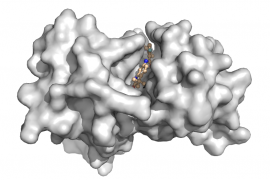The goal of the Stanford ChEM-H Medicinal Chemistry Knowledge Center is simple - to help biologists and clinicians at Stanford to incorporate medicinal chemistry into their ongoing and future research endeavors.

The Stanford ChEM-H Medicinal Chemistry Knowledge Center is led by Dr. Mark Smith, Ph.D., formerly a senior research scientist at Roche Pharmaceuticals. Interested faculty are encouraged to take advantage of Dr. Smith's presence at Stanford to benefit their research programs.
The Stanford ChEM-H MCKC consists of ~1,000 sq feet of laboratory space, consisting of 8 fully equipped synthetic chemistry fumehoods, located in the Center for Clinical Scientific Research and the Beckman Research Center within the Stanford School of Medicine. Major equipment consists of a Shimadzu analytical LCMS, Agilent Semi-prep HPLC, a Biotage microwave reactor and two Analogix automated flash chromatography instruments. In vitro and in vivo ADME assays are performed in close collaboration with either Stanford core service centers or at local contract research organizations. The Medicinal Chemistry Knowledge Center has access to state of the art informatics infrastructure that includes the Dotmatics drug discovery platform for data capture, query and visualization and Schrodinger’s Maestro software molecular modeling.
Recent Publications
SAR optimization studies on modified salicylamides as a potential treatment for acute myeloid leukemia through inhibition of the CREB pathway, H. Chae, N. Cox, S. Capolicchio, J.W. Lee, N. Horikoshi, S. Kam, A.A. Ng, J. Edwards, T. Butler, J. Chan, Y. Lee, G. Potter, M.C. Capece, C.W. Liu, S. Wakatsuki, M. Smith, K.M. Sakamoto. Bioorganic and Medicinal Letters, 2019.
Zinc-Chelating Small Molecules Preferentially Accumulate and Function within Pancreatic β Cells, T.M. Horton, P.A. Allegretti, S. Lee, H.P Moeller, M. Smith, J.P. Annes. Cell Chemical Biology, 2018, 26.
CC-401 Promotes β-Cell Replication via Pleiotropic Consequences of DYRK1A/B Inhibition, Y. Abdolazimi, Z. Zhao, S. Lee, H. Xu, P. Allegretti, T.M. Horton, B. Yeh, H.P. Moeller, R.J. Nichols, D. McCutcheon, A. Shalizi, M. Smith, N.A. Armstrong, J.P. Annes. Endocrinology, 2018, 159, 3143-3257.
A Gut Commensal-Produced Metabolite Mediates Colonization Resistance to Salmonella Infection, A. Jacobson, L. Lam, M. Rajendram, F. Tamburini, J. Honeycutt, T. Pham, W.Van Treuren, K. Pruss, S. R. Stabler, K. Lugo, D.M. Bouley, J. G. Vilches-Moure, M. Smith, J.L. Sonnenburg, A.S. Bhatt, K.C. Huang, D. Monack. Cell Host and Microbe, 2018, 24, 296-307.
Niclosamide suppresses acute myeloid leukemia cell proliferation through inhibition of CREB-dependent signaling pathways, H.D. Chae, N. Cox, G.V. Dahl, N.J. Lacayo, K.L. Davis, S. Capolicchio, M. Smith and K.M. Sakamoto. Oncotarget, 2018, 9:4301-4317.
Integrin-Targeting Knotting Peptide-Drug Conjugates Are Potent Inhibitors of Tumor Cell Proliferation, N. Cox, J. Kintzing, M. Smith, G. Grant and J. R. Cochran. Angew. Chem. Int Ed., 2016, 55, 9894.
Parallel shRNA and CRISPR-Cas9 screens enable antiviral drug target identification. R. M. Deans, D. W. Morgans, A. Okesli, S. Pillay, M. A. Horlbeck, M. Kampmann, L. A. Gilbert, A. Li, R. Mateo, M. Smith, J. S. Glenn, J. E. Carette, C. Khosla and M. C. Bassik. Nature Chem. Bio. 2016, 12, 361.
Small molecule screen for inhibitors of expression from canonical CREB response element-containing promoters. B. Mitton, K. Hsu, R. Dutta, B.C. Tiu, N. Cox, K.G. McLure, H.D. Chae, M. Smith, E.A. Eklund, D.E. Solow-Cordero, K.M. Sakamoto. Oncotarget. 2016, 7, 8653-62.
*MCKC Members are listed in BOLD
Open Positions
Interested in joining the ChEM-H MCKC?
We are seeking accomplished and motivated Postdoctoral Research Associates with a strong background in synthetic organic chemistry and a desire to work in drug discovery. Successful candidates will work closely with collaborators in existing biomedical research laboratories at Stanford and are expected to play a key role in the advancement of promising small molecule agents into the clinic for the purpose of testing innovative therapeutic hypotheses. The position requires a recent graduate with a Ph.D. in organic chemistry who is experienced with a wide range of synthetic reactions and competent with modern spectroscopic methods applied to structure determination including 1H and 13C NMR and mass spectrometry. Experience with modern purification technology is essential.
Applications should be sent to Dr. Mark Smith (mxsmith@stanford.edu) and include a resume, research abstract and contact information for two referees.



